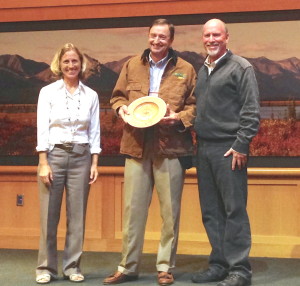Stroud Water Research director honored for Chesapeake restoration work

Bern Sweeney (center) receives the 2013 Lifetime Achievement Forest Champion award. Displaying a handcrafted, wooden bowl with the engraving “Chesapeake Forest Champion 2013,” Sweeney is joined by Al Todd (right), the Alliance for the Chesapeake Bay’s executive director, and the U.S. Forest Service’s Chesapeake Liaison, Sally Claggett.Photo courtesy of Alliance for the Chesapeake Bay
Stroud Water Research Center Director Bern Sweeney was honored by the Alliance for the Chesapeake Bay and the U.S. Forest Service at the opening ceremonies of the 2013 Chesapeake Watershed Forum last month, a news release from the Avondale-based center said.
Attended by nearly 500 conservationists, scientists, and educators from Sept. 27-29, the event celebrated 30 years of the Chesapeake Bay restoration effort. The award recognized the outstanding effort of Bern Sweeney throughout his career to conserve, restore, and celebrate Chesapeake forests in order to improve the quality and health of the Chesapeake Bay, the release said.
At the ceremony, Sweeney was recognized for his landmark scientific publications during the past three decades regarding the role that streamside forests play in the quality of water in streams, rivers, and estuaries. He was applauded for a statement made in his 1992 scientific article that jump-started the movement to use tree planting along tributaries to help clean up the Chesapeake Bay:
“In this paper I suggest that the quality of streamside forests may be the single most important factor altered by humans that affects the structure and function, and ultimately water quality, of the streams providing water to the coastal embayments,” Sweeney said.
It was also pointed out that he has personally organized the planting of over 100,000 trees in a variety of large field experiments throughout the mid-Atlantic region — moreover, that the publication of data associated with these pioneering experiments contributed significantly to the current technology used to create streamside forest buffers to protect and enhance the region’s water quality.
Sweeney is the first recipient of the Forest Champion award in the new Lifetime Achievement category.
Beyond the benefits to the bay, forests provide clean water and air, wildlife habitat, recreational opportunities, and a host of other benefits to people. “In rural and urban areas alike, trees are one of our greatest allies in reducing the pollution that flows off the land into local waterways and, ultimately, to the bay,” said Sweeney.
With 100 acres of the region’s forest lost to development each day, the need for local champions of trees and forests has never been greater, the release said. To learn more about the benefits of streamside forest buffers, go to http://www.stroudcenter.org/education/communities/buffers.






